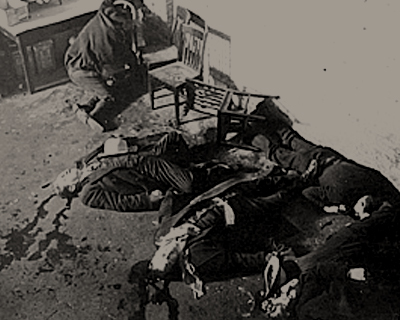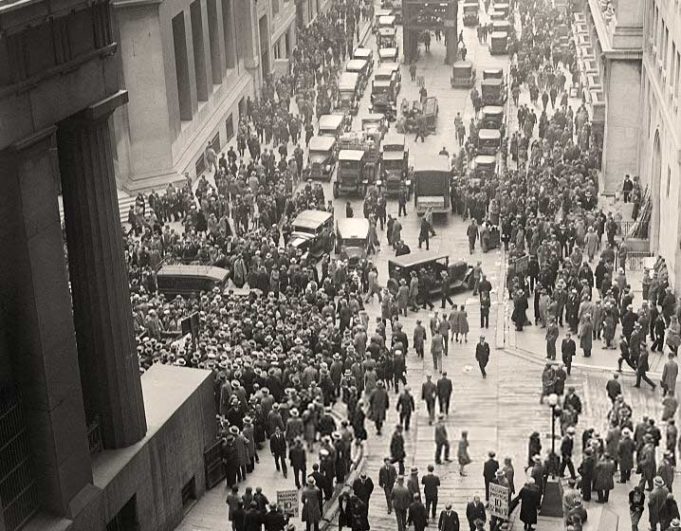1 – The Stock Market Crash
The Great Depression was a severe worldwide economic depression that took place during the 1930s.
The Great Depression started in most countries in 1929 and lasted until the late 1930s. It was the longest, deepest, and most widespread depression of the 20th century.
In the 21st century, the Great Depression is commonly used as an example of how far the world’s economy can decline.
The depression originated in the United States, after a fall in stock prices that began about September 4, 1929, and became worldwide news with the stock market crash of October 29, 1929, known as Black Tuesday.
Between 1929 and 1932, worldwide GDP fell by an estimated 15%. By comparison, worldwide GDP fell by less than 1% from 2008 to 2009 during the Great Recession.
The negative effects of the Great Depression lasted in many countries until the beginning of World War II.
The Great Depression had devastating effects in countries both rich and poor. Personal income, tax revenue, profits, and prices dropped, while international trade plunged by more than 50%.
Unemployment in the U.S. rose to 25% and in some countries rose as high as 33%.
2 – St. Valentine’s Day Gangland Massacre

Chicago History Museum / Wikimedia Commons / CC-BY-SA-3.0 / GFDL
The Saint Valentine’s Day Massacre is the name given to the 14 February 1929 murder of seven men of the North Side Irish gang during the Prohibition Era.
It resulted from the struggle between the Irish American gang and the South Side Italian gang, led by Al Capone, to take control of organized crime in Chicago.
Former members of the Egan’s Rats gang were suspected of a significant role in the incident, assisting Capone.
The St. Valentine’s Day Massacre was never officially linked to Capone, but he was generally considered to have been responsible for the murders.
Though the Massacre marked the end of any significant gang opposition to Capone’s rule in Chicago, it can also be said to have been the beginning of his downfall.
Due to his impressive organization, income and willingness to ruthlessly eliminate his rivals, Capone became the country’s most notorious gangster.
3 – The Lateran Treaty Establishes an Independent Vatican City

The Lateran Treaty was an agreement made in 1929 between the Kingdom of Italy and the Holy See, settling the “Roman Question”.
They are named after the Lateran Palace, where they were signed on February 11, 1929.
The Italian parliament ratified them on June 7, 1929. Italy was then under a Fascist government, but the succeeding democratic governments have all upheld the treaty.
It recognized the Vatican as an independent state, with Prime Minister Benito Mussolini agreeing to give the church a financial refund.
In 1947, the Lateran Pacts were incorporated into the democratic Constitution of Italy.
The agreement was signed for King Victor Emmanuel III of Italy by Benito Mussolini, Prime Minister, and signed for Pope Pius XI by Pietro Gasparri, Cardinal Secretary of State.
4 – Chile and Peru Sign the Treaty of Lima
The Treaty of Lima was a series of documents that settled the territorial dispute of both Tacna and Arica provinces of Peru and Chile respectively.
According to the Treaty, the Tacna-Arica Territory was divided between both countries; Tacna being awarded to Peru, with Chile retaining sovereignty over Arica. Chile also agreed to pay up to 6 million dollars in compensation to Peru.
The Treaty was signed on June 3, 1929, in the city of Lima by Peruvian Representative José Rada y Gamio and Chilean Representative Emiliano Figueroa Larrain.
The controversy was a direct aftermath of the War of the Pacific (1879–1883), which involved Chile against Peru and Bolivia.
Chile won the war and conquered the Peruvian territories of Tarapacá, Tacna, and Arica. The deal they reached allowed Peru to reacquire Tacna while Chile kept Arica.
Chile had also to make some concessions such as building a Peruvian-administered wharf in Arica and pay a six-million-dollar indemnification, among other provisions.
In 1999, Chile and Peru, at last, agreed to fully implement the Treaty of Lima, providing Peru with access to port facilities in Arica.









